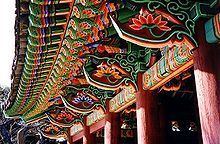Gangwon-do
Coordinates: 37 ° 30 ' N , 128 ° 18' E
| Gangwon-do | |
|---|---|
| Hangul : | 강원도 |
| Hanja : | 江原道 |
| Revised Romanization : | Gangwon-do |
| McCune-Reischauer : | Kangwon-do |
| Basic data | |
| Surface: | 16,894 km² |
| Residents: | 1,518,040 (as of 2015) |
| Population density : | 90 inhabitants per km² |
| Structure : | 7 cities ( Si ) 11 counties ( Gun ) |
| Administrative headquarters : | Chuncheon |
Gangwon-do is a province in northeastern South Korea on the East Sea . In the south it borders on Gyeongsangbuk-do and Chungcheongbuk-do , in the west on Gyeonggi-do and in the north on North Korea . The capital of the province is Chuncheon .
history

The former Gangwon-do province, which emerged in the Joseon period , was divided along the 38th parallel during the American-Soviet occupation in 1945 and after the Korean War 1950-1953 the Demilitarized Zone (DMZ) ran through the area. The present-day provinces of Gangwon-do (South Korea) and Kangwŏn-do (North Korea) have the same Korean name in different transcriptions. An exchange between the two provinces is still possible to a limited extent. Smaller cooperation projects at the provincial level are already helping to improve the inter-Korean dialogue.
geography
The largest cities in Gangwon-do, besides the capital Chuncheon, are Gangneung , Sokcho and Wonju .
The topography is characterized by the rugged low mountain range, which run in a north-south direction and of which the Taebaek Mountains are the most important. The course of the mountains makes traffic management difficult, so roads and railroad lines follow the winding river valleys, some of which have been expanded by erosion. The river beds are wide, the rivers themselves narrow and shallow for most of the year. In the rainy season and after the snow has melted, they swell into torrents. The mountains often drop steeply to the coast, forming small bays with picturesque sandy beaches. There is a continuous wide sandy beach only in the north at Samcheok, which is in the flat alluvial land, and at Gangneung.
The climate is a bit rougher than in the western and southern provinces, during the rainy season in summer it is muggy. The most beautiful season besides spring, which usually begins at the end of February, is autumn. The vegetation shines in all imaginable colors, it corresponds to the "Indian Summer" in the New England states of the USA. The winters are cold, with extremely dry air, characterized by the cutting north and east winds. Temperatures of minus 20 degrees are not uncommon. Often up to 20 cm of snow falls in one day. The sun often shines even in winter.
economy
Mining is important, as it is still carried out in tunnels in numerous, often small, mines. There are also several modern mines with shafts up to 1000 m deep. South Korea's largest coal mine is located in Jangseong. The coal is processed into the traditional round briquettes ( yontan ), which are used as fuel in the countryside and often also in cities. In addition, tungsten, lime and various minerals are mined.
The mountains are heavily forested, with a large part having been laboriously reforested after the clearing under Japanese rule from the 1960s. The forests offer an abundance of mushrooms, herbs and tasty fruits. Agriculture is limited to the river valleys and alluvial areas in the east and west of the province. Recently, food companies have been using some mountain pastures for dairy farming. The main products are rice, barley, sweet potatoes, potatoes and vegetables. An important role is played by the fishery, which catches all kinds of fish and seafood, especially squid, in the fish-rich Sea of Japan. In addition, mussels and seaweed are harvested in the flat coastal areas.
tourism
The 1700 m high Seoraksan massif near Sokcho is the most popular excursion destination for Koreans due to its unique topography and flora and is mostly overrun by visitors. The 1563 m high mountain Odae-san with its ski slopes also attracts many tourists. Both mountains are in national parks. The beaches of Gangneung are a popular bathing area in summer.
Administrative division
Gangwon-do is divided into 7 urban and 11 rural districts.
Cities
- Chuncheon -si ( 춘천시 , 春川 市 ) - provincial capital
- Donghae -si ( 동해시 , 東海 市 )
- Gangneung -si ( 강릉시 , 江陵 市 )
- Samcheok -si ( 삼척시 , 三 陟 市 )
- Sokcho -si ( 속초시 , 束草 市 )
- Taebaek -si ( 태백시 , 太白 市 )
- Wonju -si ( 원주시 , 原 州市 )
Counties
- Cheorwon -gun ( 철원군 , 鐵 原 郡 )
- Goseong -gun ( 고성군 , 高 城 郡 )
- Hoengseong -gun ( 횡성군 , 橫 城 郡 )
- Hongcheon -gun ( 홍천군 , 洪川 郡 )
- Hwacheon -gun ( 화천군 , 華 川 郡 )
- Inje -gun ( 인제군 , 麟 蹄 郡 )
- Jeongseon -gun ( 정선군 , 旌 善 郡 )
- Pyeongchang -gun ( 평창군 , 平昌 郡 )
- Yanggu -gun ( 양구군 , 楊 口 郡 )
- Yangyang -gun ( 양양군 , 襄陽 郡 )
- Yeongwol -gun ( 영월군 , 寧 越 郡 )
Web links
- Province website (English, other languages can be selected)

